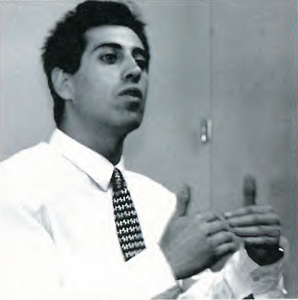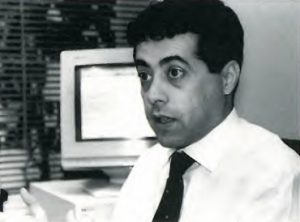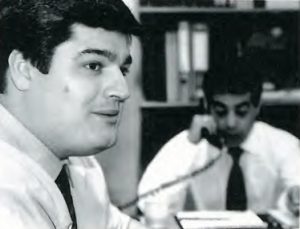This interview by J. Luis Sanz originally appeared in the July/August 1995 issue of the Spanish video game magazine Ultima Generación (the Spanish version of Next Generation magazine). In it, three of Sega Amusements Spain discuss the manufacturer’s origins in the country and plans for expansion. It’s a fascinating look at how Sega operated in Spain told from the people who lived it.
***
The division that maintains Sega’s power worldwide and is the reason why the company exists shares its future plans with us. To speak of amusement machines is to speak of Sega Amusements, and the three names that guide its path in our country are [Managing Director] Mario Cotza, [Senior Operations Manager] George P. Taylor, and [Sales Manager] Angel G. Gallego – three men and one destiny.

Ultima Generación: How was Sega Amusements started in Spain and what caused the enormous delay in its definitive inclusion in Sega Consumer headquarters?
Mario Cotza: Making this idea a reality has taken us years of struggle against bureaucracy. Sega Amusements was started in Spain because type A machines (amusement) and type B (slot machines) fall under the same regulation, causing the Ministry of the Treasury to be very strict.
We’ve had to create a new business whose latest stockholder is Sega of Japan. Sega Amusements works differently than Sega’s Consumer business.
Ultima Generación: Spain is different?
George Taylor: Yes, it’s kind of hard to explain that in to distribute a machine, we have to get the approval of the National Gaming Commission. Here, because of that misconception surrounding the word “game,” video games suffer the same control situation as slot machines. In Britain, you just go and install the machine.
Ultima Generación: How much territory does Sega Amusements Spain cover?
Mario Cotza: For Sega, Europe is divided into two different parts. One of them is us, Sega Amusements Spain, which runs from the Pyrenees [a mountain range that forms a natural border between Spain and France] and the Alps on down, and when I say “down,” I mean all the way to South Africa, including Italy, Greece, and Portugal. The other part, obviously, is the north, which is run by our London business.
Ultima Generación: How is your internal structure composed?
Angel Gallego: There are two divisions. One of them is sales and the other is operations. The former is in charge of selling to distributors, AmuseTEC in this case. We always work with only one official distributor. The operations division, run by George, handles the family gaming centers that we plan to open shortly.
Ultima Generación: Did your sudden entry into Spain have anything to do with the company’s global policy to support the launch of its new console?
Angel Gallego: The answer is clear and concise: Consumer is one thing and Amusements is something else entirely. The former interacts with the public directly, deals with them, and sells them its product, while we only inform them.
Mario Cotza: Moreover, Amusements is the professional world of video games. Saturn, the new system that Sega Consumer is launching, is a product that’s technologically farther behind than say, Sega Rally. Consumer and Amusements can never be equal because we’re always ahead of them. We deal with people who spend their time out of their homes. In the professional world, everything comes down the machine, time, and profit. So, our games are designed under that premise, while for games made for home consoles time is most important.
George Taylor: Why do you think Amusements exists? It’s an enormous and privileged test market that can tell Consumer, distributor of the home consoles, what direction the market is heading and what consumer tastes are. For every Sega Rally cabinet we sell worldwide, the home market sells 10 times as much.
Mario Cotza: Our product is professional and offers a realistic simulation; you have the explosive sensation of true competition – you against me. That kind of feeling just doesn’t exist in the home market, no matter how many multi-taps you connect to your console.
Angel Gallego: That’s why Sega works in both markets, which are complimentary. The home games are more targeted towards early ages, 15 o 16, up to ages 25 or 30. Coin-op machines are like puzzles: from kids to the elderly, everyone can enjoy them indiscriminately.
Ultima Generación: Can you tell us how an idea becomes a Sega Rally, a Virtua Fighter, or a Daytona USA?
Mario Cotza: Sega’s development teams work as separate groups, each with complete independence, and they develop everything from the initial idea to the graphics. First, they have to inform their department heads what they are doing, and then, once the project is underway, they get together to determine if its worth continuing or not.
The independence of these groups is total; some work up to 20 hours a day or sleep on their office desks. They’re geniuses; they only care about their idea and they constantly look for revolutionary concepts. In the end, of around 300 or 400 ideas, only about 10 titles are left, and in some cases, this may be determined by development teams from other businesses.

Ultima Generación: And the famous AM2 and AM3 teams belong to these groups?
Mario Cotza: Yes. AM1, AM2, AM3, and AM4 have their own structures. Groups one, two, and three develop software and group four works with hardware, both home and amusement, and designs the cabinets and the equipment needed for the game.
Ultima Generación: Do you think it’s possible to find many game rooms in the Spanish market that are willing to invest in machines that are priced higher?
Angel Gallego: That is precisely one of the purposes we have for establishing Sega Amusements Spain: change the market’s mentality, differentiate between what were the pool rooms of old and what are now family entertainment centers.
Ultima Generación: And those new operators are willing to spend large amounts of money?
George Taylor: No. One has to be professional. It’s the same situation as these “sandwich” shops that have popped up everywhere – the most modest ones imitate the large chain stores and that helps that sector of business clean its image. Those that aren’t professional will disappear.
Mario Cotza: Game rooms are going to change to give a new generation a clean place where they can see each other. The small places should change and adopt a style that will please people. If you have 50 upright machines, you should remove 10 and put some tables in so people can sit and talk. It’s been proven that people want places to spend their time, and we’re going to show that when we open our centers.
Ultima Generación: So, your goal is that these entertainment centers become another leisure option, like the cinema?
George Taylor: The important thing is the evolution of what has been thus far a mostly negative perception of recreation centers and pool rooms. They shouldn’t be limited to attracting only young people and should target everyone from two to 92 years of age. Another important obstacle that most be overcome is the reaction many people get when they enter a game room: the fear of making fools of themselves. We have to offer quality, a good environment and good service, and take care of our customers with uniformed employees that people know work for Sega and can tell them what the controls in Daytona do. There isn’t a single Sega game center in the entire world that doesn’t have an information desk that tells you where the restrooms are, how you play each game, or if there are any virtual reality games.
Ultima Generación: Does Sega manufacture its games while there’s a demand, or is there a target number that has to be met, no matter what?
Mario Cotza: Our view is that a game should always have value, so we never manufacture it for an extended period. Daytona has the record because its production was extended to 10 months due to high demand.
Ultima Generación: What do you mean when you say that the games should have value?
Mario Cotza: If you go into any game room, you’re sure to find Sega machines from eight years ago. OutRun, currently, is still in operation. We could have manufactured OutRun for two years, and we would have sold a lot, but we did it over a reduced period so that today, precisely, the game would have value.
Ultima Generación: What was the real reason that made Sega decide to open entertainment centers in Spain?
Mario Cotza: One of our pilot programs took place during the past Olympics in Barcelona. In the Olympic stadium, we opened a 500-square foot entertainment center that included all kinds of games, like the R-360 and the deluxe cabinet of Galaxy Force. We created an environment that was very reserved and special by applying our philosophy. The results were spectacular, and all the athletes admitted to playing the games that were there. We even had to hire a guard to control things, since the most famous athletes sent kids to hold their places in line. Imagine Carl Lewis sending a kid to hold his spot so he could play a game! [Martín López] Zubero, for example, played before training, at six a.m. We opened the game room early just for him. For the first time, people could see adults having fun just like kids with the amusement machines. The discotheque, on the other hand, was a failure.
George Taylor: In the end, it’s fundamental to offer a good image and quality service. Your brand should be known for service and fun. That’s why Sega’s centers will be fundamental for the evolution of this sector. Average people who aren’t from the gaming world probably don’t understand that Sega is technology and sells it to the whole world; we aren’t closed to any idea. It would be great if the business could adapt a style, a new concept, and a professionalism that only exists now in a few sectors.
Ultima Generación: So the concept that will drive Sega’s centers comes from those experiences you commented about?
Mario Cotza: People should choose where they want to go and when they want to spend their money. Employees can’t be all over them; the customers have to choose at all times, deciding freely if they want to spend their money to play. There can’t be anyone around them, asking them all the time what they want, but there should be someone there to help them if they need it.
Ultima Generación: Do you know where you’re going to open the first ones?

George Taylor: Obviously, they can only be opened in places where a certain number of services are guaranteed, services like access and commercial movement. That’s important. Every time Sega opens a family entertainment center, it’s different from the others – a welcoming environment but with corporate guidelines that set us apart. We have to be the engine, through experience and volume, that forces the sector to take this much-needed turn.
Ultima Generación: Are you taking on this project independently?
George Taylor: No. Sega always looks for what’s called a “joyventure,” a partner that’s truly convinced that their investment isn’t just solid but that will also present them with an image that will let them increase their prospects and investments.
Ultima Generación: What’s the process for getting in contact with these businesses?
George Taylor: Obivously, our company hasn’t published an ad in the newspaper but has instead sought out leading companies to open these first centers in Spain. We don’t refuse to offer information so that anyone interested in doing business with us can do it freely.
It’s important to keep in mind that a Sega family entertainment center needs a location no less than 400-square feet in size, big enough so that people can feel happy and there can be a respectable number of machines.
Ultima Generación: I’m going to insist with my question. Do you know where you’re going to open them?
George Taylor: I can confirm that we are going to open one in Madrid and another in Valencia. The exact dates? We haven’t settled on them but they’ll be soon.
Ultima Generación: Will the centers have exclusive games?
George Taylor: All types of machines will be in our centers, from Sega Rally and Daytona USA to air hockey and one called Speedshot, which is a soccer game, but electronic. Other products, like Desert Tank or Star Wars, will round out the catalog. We’re the first to see that there are other companies that have good products, even if they are hard to find [laughs], and for that reason they’ll be involved, because the public demands it. Sega’s centers will be quality because basically, Sega’s products are quality.

Recent Comments